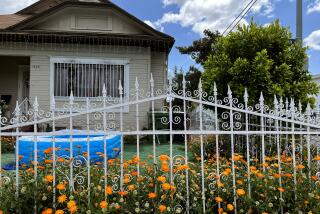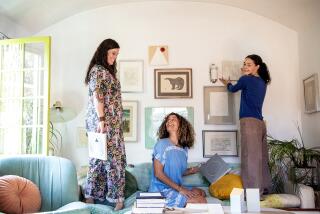McMansions eat up traditional backyards as interiors trump exteriors
The scene in one unassuming 1920s and ‘30s Los Angeles neighborhood is increasingly familiar. Simultaneously springing up within two blocks, on modest 6,500-square-foot lots that once held single-story homes of less than 2,000 square feet, are four massive two-story constructions of 5,000 square feet each that aggressively push the limits of the lot lines — classic mansionization. It’s not just a wealthy neighborhood phenomenon. Throughout the city, homeowners are choosing to add on, build up and build out.
While much has been written about the issues these large structures pose to privacy, light, airflow and community, one casualty hasn’t received as much attention. These rebuilt lots frequently have only the slimmest of backyards. This new formula of giant house-tiny yard turns on its head the seminal Southern California middle-class dream: a decent, but not extravagant, house with a comfortable yard for the family to play in. Increasingly, the choice is larger interior private space at the expense of outdoor private space. In a city coveted for its near-perfect climate, the question is: Why?
We want more
Homeowners at a certain income level expect more from their houses than in the past — a fact readily apparent to the real estate business. “It’s a different breed of people here today,” says Realtor Ron Wynn, who has worked on the Westside for more than 30 years. “There are a lot of young people used to earning a lot of money and used to being very comfortable.”
“Comfortable” translates to a desire for bigger spaces, more amenities and higher-quality materials than in the past, notes John Closson, vice president and regional manager of Berkshire Hathaway Home Services.
Lifestyle changes
In many cases, the yard is not the family center it used to be, says architect Hsinming Fung, director of academic affairs at the Southern California Institute of Architecture. “What a family would do together for entertainment value is no longer in the backyard or the frontyard,” Fung says. “Technology has completely changed the way we use space. They need the indoor space because they use it much more.”
Multiple entertainment centers and sophisticated home offices are now vital to home life, Closson points out. “When we grew up, we had a den where we watched TV. Why would you need a big home office in 1960? [Today] people will sacrifice some yard space to make sure they have these core interior spaces.”
There’s another factor at work: the trend toward larger interior space to accommodate aging parents and post-college children — think suite instead of guest room.
Blame economics
A simple — some say brutal — development equation is at work today: More square footage equals greater return on investment. “Obviously, the price of land continues to climb in Los Angeles,” architect Ron Radziner of Marmol Radziner says. “Even if the client doesn’t necessarily want a bigger house, they feel they need to have it as an investment to have it make sense.”
Architect Patrick Tighe, whose preference is to build “smart, smaller homes,” puts this common theme bluntly: “They want interior space because it gives them the greatest payback in the end.”
Builders say they are simply responding to market demand. Mario Hernandez, general foreman of Truebuild Construction and Development, developers of what he calls “McMansions,” asserts these houses “sell like hot cakes.”
Los Angeles City Councilman Paul Koretz, an L.A. native, doesn’t buy it. “This is all developer driven, in my view,” he says. “I don’t believe it is driven by preferences.”
Koretz, whose 5th District covers the Westside, Miracle Mile, Hollywood and part of the San Fernando Valley, is spearheading an ordinance that will limit single-family home development to 50% of the lot’s square footage. “People still would like to have nice home with a backyard where their kids can play badminton and basketball the way I did as a kid. It’s not a bad thing to encourage kids to go outside and play in the yard.”
Yards are different
One point generally acknowledged is that many people today do not want the expense and hassle of a big yard. “It’s not practical to have a big lawn these days,” Tighe says. “People are rethinking that, rightfully so.” But they do still want something of a yard, just not the way we think of it.
For some, the talk is of “transitional space” and “blurred boundaries” — “where the yard is the house and the house is the yard,” Wynn explains. Think of open patios that flow from the interior space and include comfortable couches. A built-in kitchen and dining area with a cozy fireplace. Television and Internet access. And a gem-sized yard as part of the view.
“That backyard in a sense becomes an important room as part of the house,” says Radziner. “We can live outside if we do it right. Our clients are more interested in the quality of the space rather than the quantity of the space.”
If, indeed, Los Angeles houses, for whatever reason, are destined to overtake their yards as a matter of course, here’s one thing everyone agrees on: The key to making a successful transition to this new way of living is good design — often absent in lot-line-to-lot-line development.
“They don’t care that they are sacrificing green space and light, which to me is what makes this city special,” says interior designer Helen Meisel, board president of the Los Angeles chapter of the American Society of Interior Designers. “A sensitive architect often can find a balance between space and light. But he or she must also have a receptive client.”
More to Read
Sign up for Essential California
The most important California stories and recommendations in your inbox every morning.
You may occasionally receive promotional content from the Los Angeles Times.






